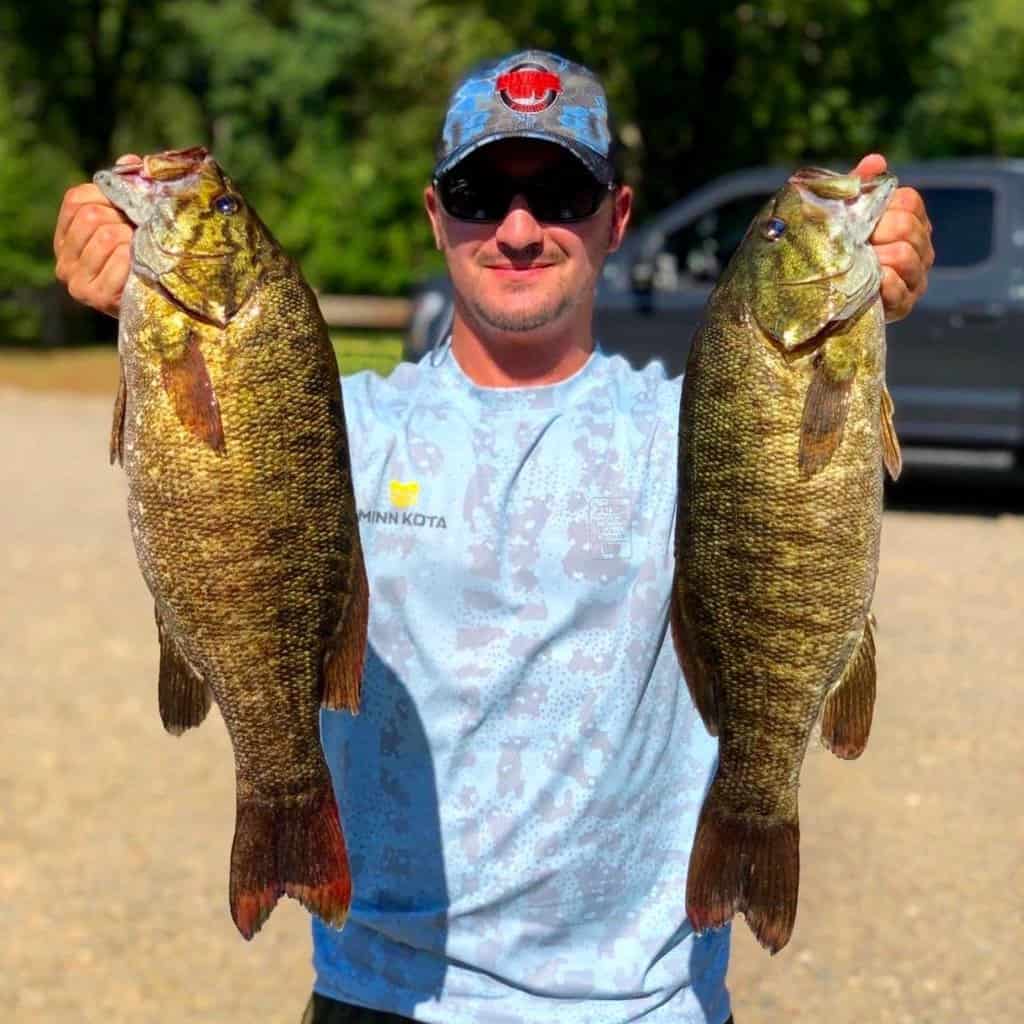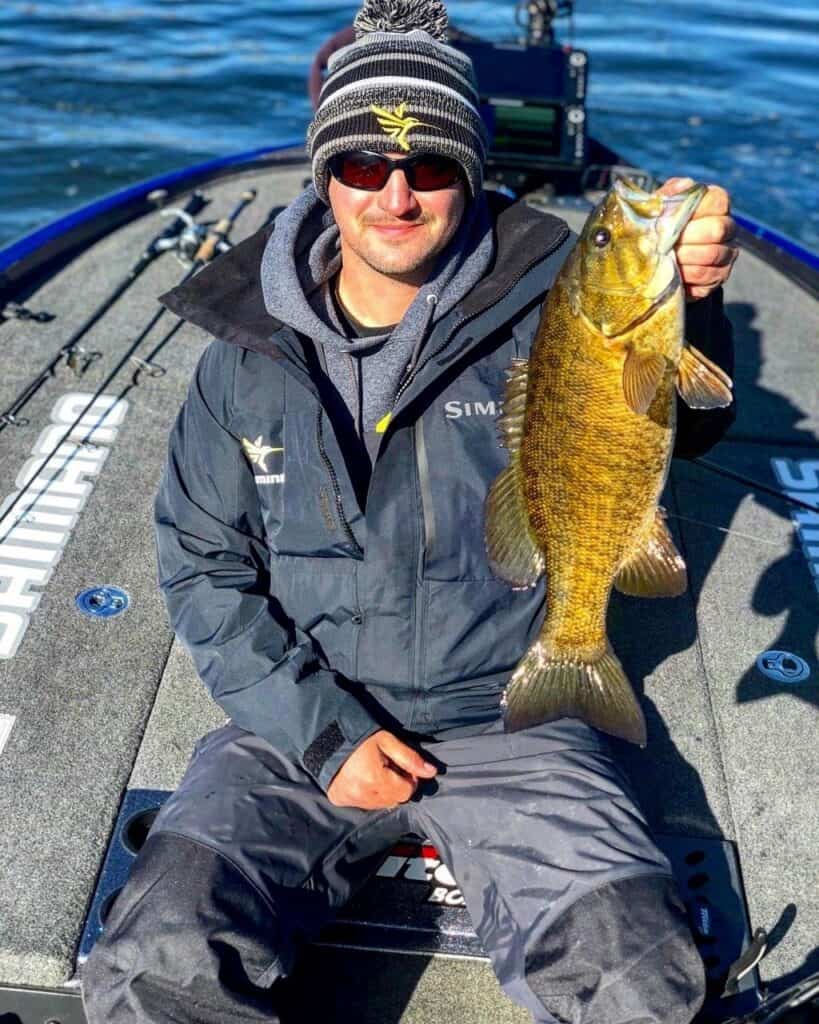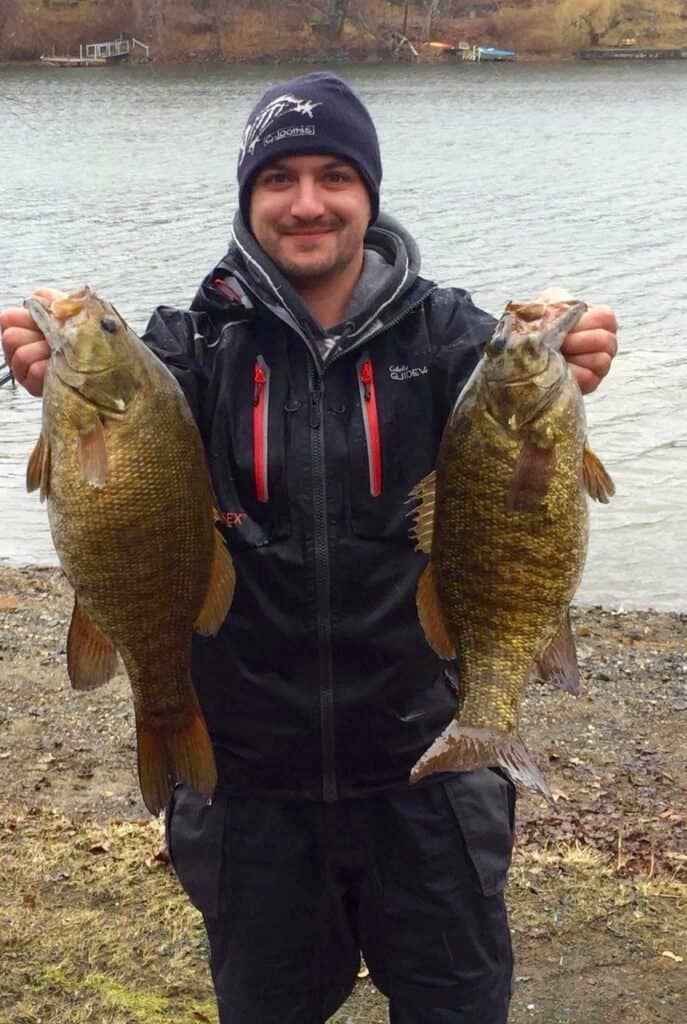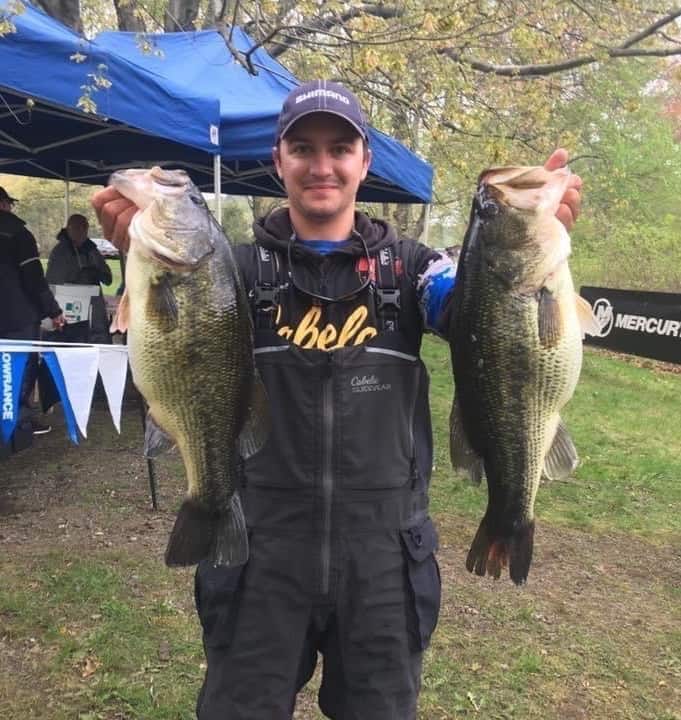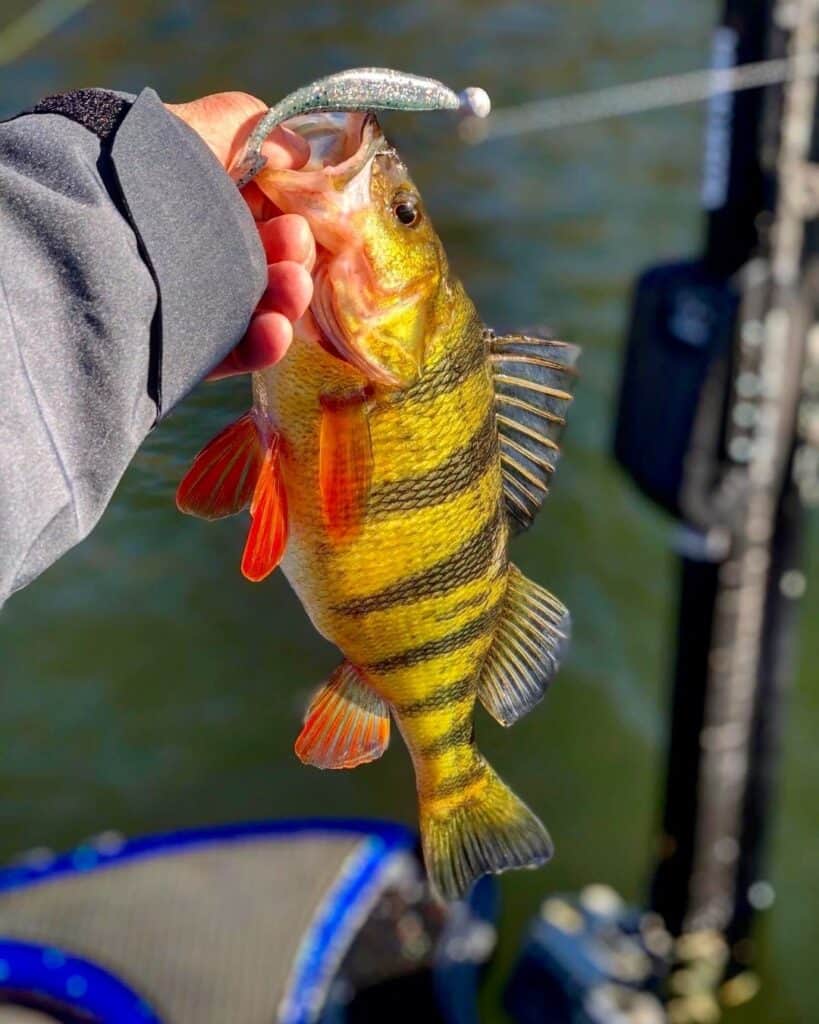In New England, a handful of lakes and reservoirs have fishing so reliably good that they draw anglers from across the region and outside the Northeast.
Candlewood Lake at the western edge of Connecticut is such a place.
Also known as Candlewood Reservoir, this big lake famously produces giant smallmouth bass, along with impressive largemouths, beautiful trout, and some of the biggest crappie and perch you’ll find anywhere in the Northeast.
When Connecticut Light and Power built this reservoir north of Danbury during the 1920s, they submerged the former town of Jerusalem beneath its 5,400-acre surface. The former town’s roadbeds and building foundations are still down there, but today they are inhabited by bass and other game fish.
To get expert insight on one of Connecticut’s premier fishing lakes, we asked Bassmaster Elite angler Alex Wetherell to break down the lake by species and season so that you, too, can catch more fish here.
Candlewood Lake is not just a tournament stop for Wetherell. He grew up in Middletown and has been fishing Candlewood Lake for years.
Candlewood Lake Bass Fishing
Candlewood is often known as a trophy smallmouth bass lake, although it also puts out trophy largemouths.
While bass species mix throughout this giant reservoir, generally, smallmouths prefer the deeper and rockier habitats more common in the northern sections of this big reservoir.
Parts of the northern section of the lake, especially where the Rocky River creek bed flows into the northwest section, have holes deeper than 90 feet, providing the kind of colder water that will hold smallmouth bass with a smattering of largemouths throughout the summer.
Largemouth bass are somewhat more common in the southern part of Candlewood Lake, closer to Danbury. There’s plenty of shallower water and excellent cover this species seeks.
Something else you should know about Candlewood Lake right up top in this article is that both bass species, and other types of gamefish too, feed heavily on alewives.
The smallish, silvery-white fish are abundant here. Anglers who learn to mimic these baitfish with their presentations already have a leg up at Candlewood.
Smallmouth Bass
Smallmouth bass in the 3-to-4-pound range make regular appearances in tournament bags at Candlewood Lake, and you’ll often find packs of smallmouths hunting together.
Spring
The keys to catching Candlewood Lake’s smallmouths in the spring are two-fold.
First, look for depth changes around islands, steep drop-offs and ledges. Second, focus on rocky bottoms, which you can often see on bright days with good water clarity.
Often the biggest smallmouths will be on the deeper beds.
Polarized lenses in a brown or amber shade will help you discern the bottom type and spot beds in shallower water. A fish finder with side-imaging capability also comes in handy.
If you see one smallmouth bed, expect others to be nearby. It’s a good bet to fish in the vicinity thoroughly.
Soft-plastic crawfish imitations can be irresistible for smallmouth bass, Wetherell advised.
The YUM Craw Papi in the smallest size fished on a 1/10th or 1/6th-ounce Pro ShroomZ jighead can be incredible.
This jighead has a barb to secure the plastic crawfish and a flat head that allows that bait to sit perpendicular to the bottom so it will hop up and down instead of lying flat or dragging along.
Jigs are another great option for catching nesting bass. Blue, black, chartreuse, and orange are excellent jig colors.
The sunken town of Jerusalem provides some particularly fishy structures for spring fishing.
Wetherell will target depths between 5 and 15 feet, looking for rock and hard bottoms with a lot of structure.
“There’s a hump called the graveyard,” he explains. It’s an old cemetery and the giant square foundation of what was once a church,” he says. “There are headstones that are still down there. It’s creepy, but the fish aren’t scared of it.”
Fishing crankbaits around the submerged tombstones can be particularly effective if you can get over the willies.
Summer
Smallmouth bass can be caught on topwater baits from late spring into early summer, often until early July, depending on water temperatures. Your best odds to bring a smallmouth bass up for a surface strike are at first or last light.
Once water temperatures begin to climb, especially in bright light, smallmouth bass will push deeper. That’s when baits like a heavier jig and trailer combination or a deep-diving crankbait in a crawfish pattern will be effective.
Also, a drop-shot rig can work magic when nothing else can buy a strike during the summer. Drop-shotting allows you to suspend a bait, like a Senko, just above a structure like a weed line or rocks for an extended period, putting it right in the strike zone.
Fall
The first half of fall, specifically mid-September through early November, can be one of the best times to fish Candlewood for a host of species, certainly for smallmouth bass.
As water temperatures drop, it will be common to see larger smallmouths patrolling flats close to drop-offs on the hunt for alewives.
The northeastern arm features steep drops with holes going as deep as 80 feet.
These transitional spots are perfect for bass ambushing schools of alewives or other prey and anglers looking for aggressive bass.
Again, keep in mind that smallmouths commonly hunt in schools, especially during the fall, as they round up baitfish.
After pulling a smallmouth from the water, quickly toss a soft plastic bait right in that fish’s wake and let it sink. White and flesh-toned plastics, including Senkos, are a great choice here.
Often one or more smallmouths will be trailing the first bass looking for scraps. Throwing a flesh-colored soft plastic bait behind that lead smallmouth can trigger this reaction strike from the followers.
If there’s anything better than a big smallmouth in the boat for a photo, it’s two of them.
Winter
Smallmouth are always popular targets through the ice on Candlewood, either on tip-ups or with lures like a Rapala Jigging Rap, white or silver soft plastic jerkbaits, or other lures that imitate alewives.
Largemouth Bass
Spring
When Candlewood Lake starts to warm, largemouth bass will move onto flats, typically near structures like docks and into creek mouths and shallow coves.
“The spring is, 100 percent, my favorite time to bass fish on Candlewood,” Wetherell said.
“When those fish move up shallow, before the spawn, when water temperatures are between 50 and 60 degrees, you’ll see your biggest bags of the entire year. You’re going to see 8-pound largemouth weighed in in April, before the spawn.”
Before bass move closer to shore, you likely will have to plumb deeper water to find them in the early spring.
Deep-running jerkbaits like a Megabass Vision 110 or a lipless crankbait like a Rat-L-Trap are good bets to target deepwater largemouth bass.
Look for cold-water bass holding off ledges, in holes, and submerged creek beds.
When the first largemouth bass do move into shallower water, roughly around mid-May, Wetherell likes throwing lures that imitate crayfish in colors such as orange. Jigs and wakebaits can be incredible options for fish pushing 5 pounds.
One of Wetherell’s favorite spring approaches is to fish submerged grass beds.
He targets these areas first thing in the morning with a topwater. As the day warms, he’ll switch to a soft-plastic jerkbait like a Zoom Fluke or a Lunker City Fin-S Fish with a split tail and throw right into the grass while fishing a little deeper.
Wetherell reads a grassline the same way you would a shoreline.
He looks for features that stand out along the vegetation line, like points and indentations.
“Look for any cuts and flip a soft-plastic bait like a jerkbait in there,” he advised.
“A hair jig, especially in the spring, can be incredible,” he said. He also recommends “small, 3-to-4-inch swimbaits that mimic the population of alewives.”
Summer
After the spawn, rising water temperatures push bass deeper. This is when you often will be able to catch largemouth bass holding around Jerusalem’s submerged roadbeds and bridges in deeper parts of the lake.
On the lake’s northern end, two massive arms have relatively deep holes that hold both types of bass once water temperatures warm.
Just north of the region known as New Milford Bay, some holes drop to about 85 feet. Drop-shotting soft plastics like a Senko along steep drops can be a terrific tactic from late June through August.
In the lake’s northwestern arm, Green and Deer islands provide steep drops and ledges that begin holding largemouths as the water warms from spring into summer. Productive spots to try are Green Island’s northwestern corner and Deer Island’s northeastern corner.
Fall
Largemouths move back into shallow water in September and October to feed more aggressively. Look for them around structures, including docks.
Allow large soft plastics, like curly-tail worms in the 7-to-10-inch range, to sink slowly and enticingly in likely holding water.
Besides alewives, the lake’s perch population makes easy meals for largemouth putting on the feedbag for the winter. So, consider casting shallow-diving crankbaits in a perch pattern where bass tend to hold.
Winter
Candlewood Lake is a particularly popular Connecticut lake for ice fishing when (and if) it freezes over.
Largemouth through the ice will take a variety of baits, but Jigging Raps, specifically in the black and silver pattern, and shiners on tip-ups are both popular choices.
Remember that the predominant forage throughout the lake is alewives, so mimic these baitfish with your lure selection, and you’ll have a good shot.
An excellent ice-fishing lure to get you started is the LIVETARGET Ghost Tail Minnow, a drop-shot bait with realistic hues to match baitfish.
Rapala’s Rap-V Blade crankbait is another bladebait that makes for a compelling alewife imitation. (Either of these lures also can work very well in open water at other times of the year.)
Catch More Bass
We have a full guide to bass fishing techniques and tips.
Candlewood Lake also earned a prominent spot in our complete guide to the best bass fishing lakes and rivers in Connecticut.
Candlewood Lake Trout Fishing
Candlewood Lake offers good numbers of brown and rainbow trout, which the Connecticut Department of Energy & Environmental Protection (DEEP) stocks annually. However, recent schedules show more browns planted than rainbows.
One proven way to catch either trout species, especially in the spring, is to work a white or chartreuse marabou jig along drops of at least 30 feet. You’ll find plenty of drop-offs that fit the bill along the western banks.
Focus on incoming streams, and your odds of finding suspending trout nearby will rise.
Let your jig sink to the bottom before hopping it slowly back to the boat.
Rising water temperatures in the summer will push trout to deeper water and increase the challenge of enticing a strike, but it won’t be impossible.
The steepest drop-offs near shallower flats are ideal habitats for summer trout. They will hunker in the deeper, cooler water and then come out in the evenings, at night, and into the early morning to hunt along the flats.
Fishing at first and last light will increase your odds of success. Night fishing is trickier but can produce some of the biggest browns of the year, if you work quietly with minimal artificial light.
The small lake arm at Ball Pond Brook on the southwest side of the lake, in the New Fairfield area, can hold good numbers of brown trout in spring and fall. However, these fish will drop into deeper portions of the lake when the water warms during the summer months.
In the fall, trout will be cruising shallower areas of the lake, especially in low-light conditions.
Just before and after sunset can be the best time to catch a big brown trout in shallow water during the early fall.
As the fall turns colder, look for these fish orienting near deeper structures where water temperatures are more stable.
Trout also fall to ice anglers during winter.
Live bait is always a top choice for catching browns through the ice, but lure anglers also turn to Jigging Raps, blade baits and jigging spoons.
The Northland Fishing Tackle’s Buck-Shot Rattle Spoon is a great ice fishing option for catching trout because it combines the flash of a spoon with the noise of a built-in rattle to bring fish to your lure.
Catch More Trout
To help you out, we’ve enlisted one of the state’s top trout anglers to compile a list of Connecticut’s best trout fishing rivers and lakes.
We also have a complete guide to trout fishing techniques, including tips for lures, baits, essential equipment, and effective tactics.
Crappie Fishing
Candlewood Lake produced Connecticut’s largest catch-and-release crappie at 19 inches, so you know this is a serious panfish fishery.
Crappie are among the most popular panfish around because they are fun to catch and delicious to eat. They also travel in schools, so catching them in excellent numbers when you can find the schools is a good bet.
Crappie are extremely structure-oriented. Finding their favorite holding spots is key.
“There are entire, fully intact, sunken trees that provide great habitat for huge crappie,” Wetherell said.
Besides submerged trees, the underwater ruins of Jerusalem and other submerged structures, docks and similar cover, and naturally steep drops also act like crappie condos.
In the spring, crappie move near shore to spawn. Focus on shallow, muddy flats and coves, especially around cover.
Small soft-plastic baits, specifically split-tail swimbaits, on 1/8th or 1/16th-ounce jig heads can be irresistible to crappie, which feed voraciously on minnows.
Try the VMC Tungsten Probe Jig in glow chartreuse. Tungsten jig heads get down in a hurry, and VMC is known for its hooks, making this a near-perfect combination.
When summer comes around, crappie move deeper and, frankly, are often tougher to find.
Look for current and structure, such as underwater humps near inflowing streams. Ideally, you’re looking for these fish at depths of around 15 to 20 feet in summer, although they can move shallower to hunt in low light.
As with trout, the area around the entrance of Ball Pond Brook on the lake’s west side is productive for crappie.
Candlewood Isle and several smaller islands provide increased structure near the stream entrance and hold crappie regularly.
If you really want to pinpoint a perfect crappie spot, find around the submerged bridge right at the creek mouth.
When the water cools in the fall, crappie move into deeper water and often stage between 20 and 40 feet.
However, they will feed aggressively as water temperatures cool off to prepare for the winter, making fall another great time for crappie fishing.
Besides jigs, smaller blade baits are another excellent option for these fish in the fall.
Megabass makes the Vibration X, Cabela’s makes a Mean Eye Blade Bait and Bass Pro Shops makes an XPS Lazer Blade. All are similar versions of the same basic bait. They are thin pieces of metal with a weighted top or head portion. The slimmer body vibrates depending on how fast you fish the lure through the water column.
The advantage of the blade bait is two-fold.
For starters, they always do something enticing, like shivering while they sink or vibrating when you pull them up.
Secondly, just about anything, from smallmouth to largemouth to crappie to trout to walleye, will hit a silver or gold blade bait. This quality makes these lures an excellent “search bait” option.
You can cast this lure a long distance on light tackle and use them to probe a given area to locate fish.
The salad plate-sized crappie on Candlewood are a particular draw for ice fishing, as they’re one of the best-tasting freshwater fish.
A great ice fishing lure choice is the Bait Rigs Slo-Poke Jig, which has a semi-circular shape to give it a slower, more fluttering fall through the water column. It can produce crappie 12 inches or larger regularly.
Catch More Crappie
Read up on the tactics and tricks that catch crappies by the bucketful in our simple crappie fishing guide.
Other Game Fish
Besides bass, trout and crappie, various sources report that Candlewood Lake has a variety of other species you can catch.
The lake has produced white perch over 15 inches and is home to plenty of yellow perch. Perch aren’t always a main draw during the open-water season, but they are an ice-fishing favorite.
Perch often bite natural baits like worms and mealworms and small lures including jigs.
Like crappie, perch will often school up, so where you find one, you will likely catch more.
More: Find perch fishing tips in our angling guide.
Other species you might catch here include:
- Sunfish, including bluegill, redbreast sunfish, pumpkinseed, and rock bass.
- Species of catfish include white catfish and several types of bullheads.
- A modest number of walleye.
- Chain pickerel.
- Common carp.
In addition, some anglers have reported catching big northern pike.
Planning Your Trip
Where is Candlewood Lake?
Candlewood Lake is in far-western Connecticut, just a few miles from the New York state line.
The southern tip is in Danbury, while the northern arms stretch clear up to the city of New Milford and the smaller town of Sherman.
Boat and Bank Access
Whether you’re looking to launch your boat, or get on the ice, the public boat launch at 8 Forty Acre Mountain Road in Danbury is a popular point of access for the southern end of Candlewood Lake.
There’s a parking area for as many as 40 vehicles and a concrete ramp.
Squantz Pond State Park on the west side of Candlewood Lake (north of New Fairfield) has boat launches into the main lake and its namesake Squantz Pond, an arm of Candlewood separated by a road-topped dike.
The launch into Candlewood from that park offers reasonable access to the western shore.
At the northwestern end of Candlewood Lake, Sherman Town Beach has a launch and boat docks.
On the northeastern arm, Lynn Deming Park in New Milford also has a boat ramp and facilities.
Several private marinas line the lake as well.
Bank access is available at various public parks.
Accommodations and Supplies
Overnighters can camp at Squantz Pond State Park on the west side of Candlewood Lake. Squantz Pond is an arm of Candlewood diked off from the main lake, and the park has access to both bodies of water, including public boat launches.
Supplies, hotels, and eateries are available nearby, including in Danbury, New Milford, and other communities.
Summary
“One of the best ways that I’ve heard fishing described,” Wetherell said, “is that it’s a living puzzle. Factors are always different; things are always changing.”
As Wetherell can attest better than most, Candlewood Lake is a beautiful living puzzle with impressively sized pieces to catch all year long.

